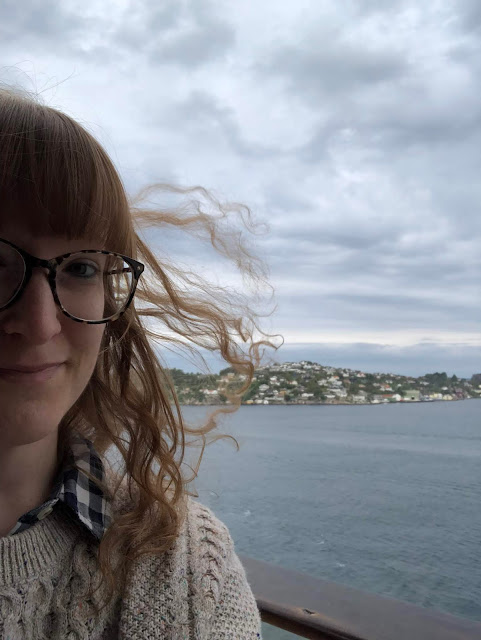Bergen was the first stop in Norway. It's known as the gateway to the fjords, as it sits not far from the open sea, and close to several fjords. It was a safe port for many boats over the centuries, and a big center for trade. Bergen is Norway's second largest city after Oslo.
We came in from the North Sea, and the water began to smooth out. Upon my first views of land, as we slowly glided along the sea water, I felt as if I had entered a fairy land, or Middle-earth. I had now entered the land of trolls and Norse mythology. Thor and Odin left their giant footprints here, and probably cracked these lands into the many islands we were passing. There were a few house scattered on said rugged islands, usually painted red.
The cold fingers of the windy sea spindled into the land. Little rocky islands, worn and smooth and rounded by the weather popped up everywhere. It was secluded out there, reaching out to the North Sea. But it grew calmer and the houses increased in number as we floated along.
The whole time, I sat outside on the back deck of the ship, sipping coffee. I was there for the nature scenery. There was no way I was going to be inside missing any moment of these views. Our huge ship somehow passed underneath a long suspension bridge before docking at the port of Bergen. I was about to step foot in Norway!
Arriving in Bergen, we set out on foot, to explore. I snapped photos along the way, as we passed museums, shops, and regular streets, but we were heading to the funicular rail, the Fløibanen, that climbs to the top of the mountain for views, and you can hike from there as well. It takes you up to Mount Fløyen, which is 320 metres (1,050 ft) above sea level in about 6-8 minutes. The views were amazing, and even though there were clouds, there was no rain. Bergen is the rainiest city in Norway, so I counted that as very lucky.
When we came back down, we did some wandering. I found a coffee shop, Kaffemisjonen, and took a daring risk on an all-Norwegian menu that had no English explanations. I had to ask the barista, and he didn't know how to translate some of it to English. I ended up with a cappuccino and a very tasty salad. I always enjoy looking at flower shops, to see what is in bloom and how they are priced, so I stopped at any along the way.
We headed down to the harbour to the famous Bryggen, a series of Hanseatic wooden commercial warehouses that are now all part of the UNESCO world historical site (now filled with touristy shops) dating from the Medieval days of trade. Here is where a main product, cod fish, would be prepped, stored, and traded. The Norwegians were experts in the fishing, and Germans came as experts in business aspects. And they all worked together during long, cold winters. It was well worth some time, just wandering between the narrow passages between buildings and observing the construction of the wooden buildings that are well protected now, but obviously burned down quite a lot in past centuries.
Here, while wandering the Bryggen, we ran into my brother, sister-in-law, and nephew as they were shopping. So, we all ended up walking around together, and eventually sat down at a cosy restaurant for some food after a while.
After some delicious food (I got tacos, so it wasn't a very Norwegian meal for me, though it was delicious, but my brother got some kind of fish. He did it right) we all walked to another area of town, where there was a large open park at a lake, which was surrounded by mountains. A pretty spot. Before I was ready to get back onto the ship, I wanted to see some of the tiny neighborhoods of classic Norwegian houses painted white with red roofs. I had no idea where they were, but I took that road, and then walked a few blocks and found my dreamy neighborhood waiting for me. Quaint and charming. Potted plants on every doorstep. Cute post boxes. I was back in another century, just for a little bit.




























No comments:
Post a Comment